|
|
|
Sort Order |
|
|
|
Items / Page
|
|
|
|
|
|
|
| Srl | Item |
| 1 |
ID:
127871


|
|
|
|
|
| Publication |
2014.
|
| Summary/Abstract |
In order to meet its 2050 target of 80% carbon emissions reduction, the UK is facing a challenge of restructuring its energy system, possibly by introducing more decentralised energy (DE) systems.Following semi-structured interviews, four exemplar international cases have been critiqued in order to investigate the variety and interrelationship of the drivers and barriers involved during their implementation, and then compared with the barriers and drivers that can potentially affect the implementation of similar projects in the UK context. The impacts of the barriers on the outcomes of these projects were evaluated, and recommendations were presented on overcoming these barriers if replicating similar projects in the UK context. Governance drivers play the most significant role, whereas financial drivers (commonly believed to be crucial), are deemed to play a lesser role. Social, governance and financial barriers rather than technological barriers constitute the central problem areas for the increased adoption of DE. The drivers and barriers experienced in the international cases were similar to those anticipated in the UK. The case studies present a high potential for replication and scaling up in the UK context and demonstrate that the increased implementation of DE systems could also enhance social and governance benefits.
|
|
|
|
|
|
|
|
|
|
|
|
|
|
|
|
| 2 |
ID:
127907


|
|
|
|
|
| Publication |
2014.
|
| Summary/Abstract |
This paper introduces a new agent-based model, which incorporates the actions of individual homeowners in a long-term domestic stock model, and details how it was applied in energy policy analysis. The results indicate that current policies are likely to fall significantly short of the 80% target and suggest that current subsidy levels need re-examining. In the model, current subsidy levels appear to offer too much support to some technologies, which in turn leads to the suppression of other technologies that have a greater energy saving potential. The model can be used by policy makers to develop further scenarios to find alternative, more effective, sets of policy measures. The model is currently limited to the owner-occupied stock in England, although it can be expanded, subject to the availability of data.
|
|
|
|
|
|
|
|
|
|
|
|
|
|
|
|
| 3 |
ID:
127872
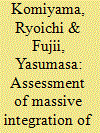

|
|
|
|
|
| Publication |
2014.
|
| Summary/Abstract |
Maximizing renewables in the country's power system has been a key political agenda in Japan after the Fukushima nuclear disaster. This paper investigates the potential of PV resource, which could be systematically integrated into the Japanese power system, using a high time-resolution optimal power generation mix model. The model allows us to explicitly consider actual PV and wind output variability in 10-min time resolution for 365 days. Simulation results show that, as PV expands, the growth of PV integration into the grid slows down when the installed PV capacity is more than the scale of the peak demand, although Japan has immense potential of installable PV capacity - equivalent to 40 times of the peak. Secondly, the results imply that a large-scale PV integration potentially decreases the usage ratio of LNG combined cycle (LNGCC) in specific seasons, which is a challenge for utility companies to ensure that LNGCC is used as a profitable compensating generator for PV variability. Finally, a sensitivity analysis on rechargeable battery cost suggests that the reason for suppressing the PV output instead of storing its surplus output by the battery can be attributed to the high battery cost; hence, the improvement of its economic performance is significant to integrate the massive PV energy.
|
|
|
|
|
|
|
|
|
|
|
|
|
|
|
|
| 4 |
ID:
127283
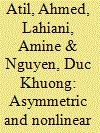

|
|
|
|
|
| Publication |
2014.
|
| Summary/Abstract |
In this article, we use the recently developed nonlinear autoregressive distributed lags (NARDL) model to examine the pass-through of crude oil prices into gasoline and natural gas prices. Our approach allows us to simultaneously test the short- and long-run nonlinearities through positive and negative partial sum decompositions of the predetermined explanatory variables. It also offers the possibility to quantify the respective responses of gasoline and natural gas prices to positive and negative oil price shocks from the asymmetric dynamic multipliers. The obtained results indicate that oil prices affect gasoline prices and natural gas prices in an asymmetric and nonlinear manner, but the price transmission mechanism is not the same. Important policy implications can be learned from the empirical findings.
|
|
|
|
|
|
|
|
|
|
|
|
|
|
|
|
| 5 |
ID:
127302
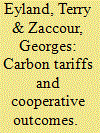

|
|
|
|
|
| Publication |
2014.
|
| Summary/Abstract |
In the absence of an international environmental agreement (IEA) on climate change, a country may be reluctant to unilaterally implement environmental actions, as this may lead to the relocation of firms to other, lax-on-pollution countries. To avoid this problem, while still taking care of the environment, a country may impose a carbon tariff that adjusts for the differences between its own carbon tax and the other country's tax. We consider two countries with a representative firm in each one, and characterize and contrast the equilibrium strategies and outcomes in three scenarios. In the first (benchmark) scenario, in a first stage the regulators in the two countries determine the carbon taxes noncooperatively, and in a second stage, the firms compete à la Cournot. In the second scenario, the regulators cooperate in determining the carbon taxes, while the firms still play a noncooperative Cournot game. In the third scenario, we add another player, e.g., the World Trade Organization, which announced a border tax in a prior stage; the game is then played as in the first scenario. Our two major results are (i) a border-tax adjustment (BTA) mimics quite well the cooperative solution in setting the carbon taxes as in scenario two. This means that a BTA may be a way around the lack of enthusiasm for an IEA. (ii) All of our simulations show that a partial correction of the difference in taxes is sufficient to maximize total welfare. In short, the conclusion is that a BTA may be used as a credible threat to achieve an outcome that is very close to the cooperative outcome.
|
|
|
|
|
|
|
|
|
|
|
|
|
|
|
|
| 6 |
ID:
127236


|
|
|
|
|
| Publication |
2014.
|
| Summary/Abstract |
While almost 30% of UK households include children, little research has attempted to present children's perspectives on home energy use. This study used focus groups with children and parents at two primary (elementary) schools in London, UK, to explore home energy use and energy feedback. Energy was found to be a little-discussed subject at home. Children derived more motivation to save energy from responsibility conferred by school activities than other (e.g. environmental) concerns, and some connected energy saving with dangers of using electricity (e.g. fire). Material and social constraints (e.g. access to outside space, parents' environmental attitudes) meant that it was sometimes difficult for children to save energy even when motivated. However, parents showed greater inclination to pay attention to energy saving when framed as supporting their child's learning than as a financial or environmental concern. Children were disinclined to reduce energy-consuming activities such as watching television, and while parents complained about children's energy use most saw it as a low priority issue. Policy implications of these findings are considered, and the approach employed is argued to be an effective way of investigating children's perceptions around energy use.
|
|
|
|
|
|
|
|
|
|
|
|
|
|
|
|
| 7 |
ID:
127299
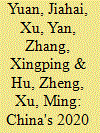

|
|
|
|
|
| Publication |
2014.
|
| Summary/Abstract |
China has proposed its 2020 clean energy target together with the climate change target of reducing CO2 intensity of the economy by 40-45% below the 2005 level. This article investigates the feasibility of these targets by testing their consistency under possible economic development scenarios. We analyse these targets from two perspectives: consistency with the overall economic growth and consistency with the international society's expectation on China's greenhouse gas (GHG) abatement responsibilities. The main findings are: under the recently announced 2020 target of gross domestic product (GDP) that is double the 2010 level, the adoption of a 15% clean energy target could result in excessive primary energy demand; and then with 40-45% GDP CO2 intensity reduction, CO2 emissions in 2020 could substantially exceed the International Energy Agency (IEA) 450 ppm scenario for China. Thus we propose a 17% clean energy target that can reconcile the domestic plan with international expectation. Our article also outlines the pathways to realise clean energy development into 2020 and proposes policy recommendations.
|
|
|
|
|
|
|
|
|
|
|
|
|
|
|
|
| 8 |
ID:
127279
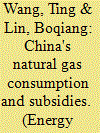

|
|
|
|
|
| Publication |
2014.
|
| Summary/Abstract |
China's natural gas consumption is growing rapidly and it has being driven by economic growth, industrialization and urbanization. In addition, the country's low-carbon development strategy, government-controlled gas price, and some other factors also contribute to the surging gas consumption. This paper studies China's natural gas consumption in residential, industrial and commercial sectors. We adopt the cointegration test and error correction model to study the relationships of explanatory factors and gas consumption of different sectors and climate factor is included into the analysis. In order to find the direction of natural gas pricing reform and establish the benchmark gas price, this paper also estimates the size of gas price subsidy by using price-gap approach. Our findings are as follows: In the long term, China's residential sector is more sensitive to price than the other two. Urbanization is an important factor promoting industrial and commercial gas consumption. Prices of other energies have an influence on natural gas consumption significantly due to the substitutability between energies. The slow-moving and unsatisfying pricing reforms on refined oil and natural gas lead to positive price elasticity of natural gas in the commercial sector, which implies that a further energy price reform is still stringent for China.
|
|
|
|
|
|
|
|
|
|
|
|
|
|
|
|
| 9 |
ID:
127295


|
|
|
|
|
| Publication |
2014.
|
| Summary/Abstract |
Sovereign Wealth Funds (SWFs) are state-owned investment funds that invest in real and financial assets. Since the global financial crisis in 2008, SWFs' investments have resulted in national security concerns of host countries because SWFs continue to expand rapidly and have become increasingly active in real-time strategic transactions. Given this background, China, which has the biggest SWF in the world, is facing severe challenges of energy resources shortages while its plan is to accomplish social and economic development goals. Energy security is a key driving force of the energy investment policy of China's SWFs. This makes the SWF investments more complicated and more politically sensitive. The combination of sovereign rights and the strategic importance of energy also makes geopolitics more complicated and brings more uncertainty to SWF investments. This article explores the relationship between energy security and energy investments of China's SWFs. It is recognised that the energy investment of SWFs must follow a sustainable path to coordinate energy security, economic growth, return on investment and national security concerns. Government policymakers are urged to balance the financial and political returns on SWFs against potential negative effects. The conclusion presents insights for policymakers, energy scholars and SWF researchers.
|
|
|
|
|
|
|
|
|
|
|
|
|
|
|
|
| 10 |
ID:
116907
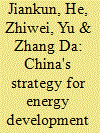

|
|
|
|
|
| Publication |
2012.
|
| Summary/Abstract |
In recent years, China has made great efforts in energy saving and carbon emission reduction by pushing forward domestic sustainable development along with global climate change mitigation. The efforts have paid off with a dramatic decrease in carbon intensity. Nevertheless, China is still confronted with tough challenges in emission control due to the fast pace of industrialization, large total historical emission and high growth rate of emissions. Therefore, China should give priority to energy saving by improving energy efficiency and sectoral structure adjustment and upgrade, and develop sustainable and renewable energy to optimize energy mix and its carbon content. China should continue to regard significant reduction of energy intensity and carbon intensity as the main objective in the near future, strive to achieve peak emissions around 2030, and realize a relatively sharp emissions reduction by 2050 in order to address climate change to meet the goal of making the warming less than 2°. During the 12th Five Year Plan (FYP), China will further strengthen measures to control the amount of energy consumption, establish a statistics, accounting and evaluation system of carbon emissions, and promote a market-based carbon emissions trading mechanism to facilitate the low-carbon transformation of China's economy.
|
|
|
|
|
|
|
|
|
|
|
|
|
|
|
|
| 11 |
ID:
127886


|
|
|
|
|
| Publication |
2014.
|
| Summary/Abstract |
The number of multi-family housing complexes (MFHCs) over 15 yr old in South Korea is expected to exceed 5 million by 2015. Accordingly, the demand for energy retrofit in the deteriorating MFHCs is rapidly increasing. This study aimed to develop a decision support model for establishing the optimal energy retrofit strategy for existing MFHCs. It can provide clear criteria for establishing the carbon emissions reduction target (CERT) and allow efficient budget allocation for conducting the energy retrofit. The CERT for "S" MFHC, one of MFHCs located in Seoul, as a case study, was set at 23.0% (electricity) and 27.9% (gas energy). In the economic and environmental assessment, it was determined that scenario #12 was the optimal scenario (ranked second with regard to NPV40 (net present value at year 40) and third with regard to SIR40 (saving to investment ratio at year 40). The proposed model could be useful for owners, construction managers, or policymakers in charge of establishing energy retrofit strategy for existing MFHCs. It could allow contractors in a competitive bidding process to rationally establish the CERT and select the optimal energy retrofit strategy. It can be also applied to any other country or sector in a global environment.
|
|
|
|
|
|
|
|
|
|
|
|
|
|
|
|
| 12 |
ID:
150449


|
|
|
|
|
| Summary/Abstract |
The Department of Defense (DOD) is the major consumer of energy within the Federal government, and it has been directed to implement cost cutting measures related to energy dependence through numerous Executive Orders and Congressional legislation. As a result, the DOD released an Energy Strategy which outlines ways to reduce energy requirements in order to meet both Presidential and Congressional mandates for energy security. With this research, we provide a historical review (1973–2014) of energy policy, legislation, and research. Additionally we identify gaps between strategy and research. The results show that DOD energy research lacks a unifying structure and guiding framework. We propose a knowledge management framework to unify and guide research efforts in direct support of the DOD Energy Strategy.
|
|
|
|
|
|
|
|
|
|
|
|
|
|
|
|
| 13 |
ID:
127233


|
|
|
|
|
| Publication |
2014.
|
| Summary/Abstract |
Through a qualitative comparative case study, this investigation examined the process by which three school districts in Wisconsin, U.S.A., developed a school energy policy and complementary energy education plan. To guide the process, the researchers created an outline of recommended steps for the districts to follow. Although there were variations in the sequence and perceived ease of the steps, the Energy Task Force members involved in the process found the outline to be a supportive guide. Further analysis of the cases involved interviewing members of the Energy Task Forces to identify facilitating and obstructing factors. The study concluded that factors such as level of environmental literacy, along with aspects of the school culture and leadership, interacted to influence the successful drafting of school energy policies and education plans. In addition to introducing an outline of recommended steps that can be used by other school policy development teams interested in promoting energy efficiency, this study adds insights into the analysis of energy policy work within the context of a school setting.
|
|
|
|
|
|
|
|
|
|
|
|
|
|
|
|
| 14 |
ID:
127301


|
|
|
|
|
| Publication |
2014.
|
| Summary/Abstract |
This paper assesses the impacts on the cement, steel and oil refining sectors in Spain of the carbon prices derived from the European Emissions Trading Scheme (EU ETS), and the potential effect on these sectors of the European Union anti-leakage policy measures. The assessment is carried out by means of three engineering models developed for this purpose. Our results show a high exposure to leakage of cement in coastal regions; a smaller risk in the steel sector, and non-negligible risk of leakage for the oil refining sector when carbon allowance prices reach high levels. We also find that the risk of leakage could be better handled with other anti-leakage policies than those currently in place in the EU.
|
|
|
|
|
|
|
|
|
|
|
|
|
|
|
|
| 15 |
ID:
127234
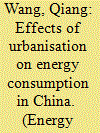

|
|
|
|
|
| Publication |
2014.
|
| Summary/Abstract |
As a key issue in China's economic development, urbanisation creates increasing pressure on energy supply and the natural environment. Thus, a better understanding of the relationship between urbanisation and energy consumption is necessary for Chinese decision makers at various levels to address energy security and sustainable economic and social development. This paper empirically investigates the effects of China's urbanisation on residential energy consumption (REC) and production energy consumption (PEC) through a time-series analysis. The results show that compared with rural areas, urbanisation slows per capita REC growth because of the economy of scale and technological advantages associated with urbanisation but has greater promotional effects on the growth of REC and the improvement of REC structure. The economic growth caused by urbanisation most significantly contributes to an increase in PEC, whereas technological advancement was found to reduce the scale of PEC (except from 2001 to 2005). Finally, the structural effect of the energy supply increased rather than decreased China's PEC, and the effect of industrial structure adjustment on PEC was found to be insignificant.
|
|
|
|
|
|
|
|
|
|
|
|
|
|
|
|
| 16 |
ID:
127291
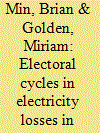

|
|
|
|
|
| Publication |
2014.
|
| Summary/Abstract |
A third of electricity in India is lost each year, where losses refer to power that is supplied but not billed. Utilizing data from the power corporation of Uttar Pradesh, India's most populous state, we study the politics of electricity losses. Examining annual data over four decades, we document that UP's electricity losses tend to increase in periods immediately prior to state assembly elections. Drawing upon geographically disaggregated data for the period 2000-09, we observe higher line losses just prior to the 2002 and 2007 state elections. Our analysis shows that the incumbent party was more likely to retain the assembly seat as line losses in the locality increased. We interpret these results as corroboration that political parties deliberately redirect electricity to flat rate and unbilled users in a context of chronically inadequate supply. Political factors appear to affect line losses in ways that technical and economic factors alone cannot explain.
|
|
|
|
|
|
|
|
|
|
|
|
|
|
|
|
| 17 |
ID:
133275
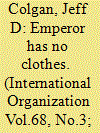

|
|
|
|
|
| Publication |
2014.
|
| Summary/Abstract |
Scholars have long debated the causal impact of international institutions such as the World Trade Organization or the International Monetary Fund. This study investigates Organization of Petroleum Exporting Countries (OPEC), an organization that purports to have significant influence over the market for the world's most important commodity-petroleum. Using four empirical tests, I find that OPEC has little or no impact on its members' production levels. These findings prompt the question of why so many people, including scholars, believe in OPEC's influence over the world's oil supply. The idea of OPEC as a cartel is a "rational myth" that supports the organization's true principal function, which is to generate political benefits for its members. One benefit it generates is international prestige. I test this idea using data on diplomatic representation and find that OPEC membership is associated with increased international recognition by other states. Overall, these findings help one to better understand international regimes and the process of ideational change in world politics.
|
|
|
|
|
|
|
|
|
|
|
|
|
|
|
|
| 18 |
ID:
128046


|
|
|
|
|
| Publication |
2014.
|
| Summary/Abstract |
Transportation contributes to resource depletion and has other negative impacts on the environment. The present study presents models of energy demand and environmental emissions for the land transportation sector in Metro Manila, Philippines from 2010 to 2040 using the "Long Range Energy Alternatives Planning (LEAP)" tool. The study projected energy demand and CO2, CO, HC, NOx and PM10 emissions for Business-As-Usual (BAU) and alternative scenarios and compared the results while aiming to determine optimal transportation policies to reduce energy demand and emissions. The results indicated that the adoption of EURO 4 emission standards provides the greatest reduction in energy use at 10.8%, while the best cases for the various gas emissions were split among different options. In addition, a combination of all of the alternatives is expected to lower energy use by 27.8% and to reduce CO2, CO, HC, NOx and PM10 by 30.3%, 60.3%, 59.0%, 48.2% and 66.4%, respectively. The analytical framework employed herein could be applied to other cities to evaluate and prioritize strategies to reduce future energy requirements and emissions.
|
|
|
|
|
|
|
|
|
|
|
|
|
|
|
|
| 19 |
ID:
132617


|
|
|
|
|
| Publication |
2014.
|
| Summary/Abstract |
Ports are characterised by the geographical concentration of high-energy demand and supply activities, because of their proximity to power generation facilities and metropolitan regions, and their functions as central hubs in the transport of raw materials. In the last decades the need to better understand and monitor energy-related activities taking place near or within the port has become more apparent as a consequence of the growing relevance of energy trades, public environmental awareness and a bigger industry focus on energy efficiency. The uptake in the port sector of innovative technologies, such as onshore power supply, or alternative fuels, such as LNG, and the increasing development of renewable energy installations in port areas, also calls for more attention to energy matters within port management.
So far, however, few port authorities have actively pursued energy management strategies. The necessity for port authorities to actively manage their energy flows stems from their efforts to plan, coordinate and facilitate the development of economic activities within the port, and as a consequence of the heavier weight that sustainability is given within the port management strategies.
Through the analysis of the experiences of two European ports, Hamburg and Genoa, that have already attempted to coordinate and rationalise their energy needs, this paper will argue that for the ports of the future active energy management can offer substantial efficiency gains, can contribute to the development of new alternative revenue sources and in the end, improve the competitive position of the port.
|
|
|
|
|
|
|
|
|
|
|
|
|
|
|
|
| 20 |
ID:
127305


|
|
|
|
|
| Publication |
2014.
|
| Summary/Abstract |
The emergence of biofuel as a renewable energy source offers opportunities for significant climate change mitigation and greater energy independence to many countries. At the same time, biofuel represents the possibility of substitution between energy and food. For developing countries like India, which imports over 75% of its crude oil, fossil fuels pose two risks-global warming pollution and long-term risk that oil prices will undermine real living standards. This paper examines India's options for managing energy price risk in three ways: biofuel development, energy efficiency promotion, and food productivity improvements. Our salient results suggest that biodiesel shows promise as a transport fuel substitute that can be produced in ways that fully utilize marginal agricultural resources and hence promote rural livelihoods. First-generation bioethanol, by contrast, appears to have a limited ability to offset the impacts of oil price hikes. Combining the biodiesel expansion policy with energy efficiency improvements and food productivity increases proved to be a more effective strategy to enhance both energy and food security, help mitigate climate change, and cushion the economy against oil price shocks.
|
|
|
|
|
|
|
|
|
|
|
|
|
|
|
|
|
|
|
|
|